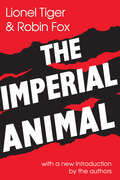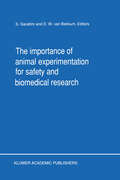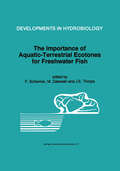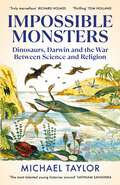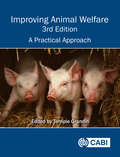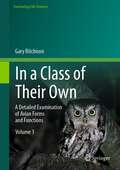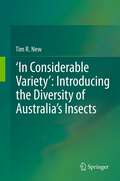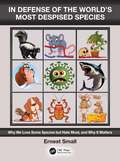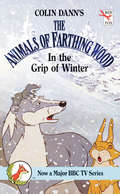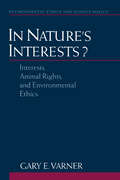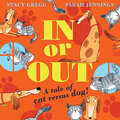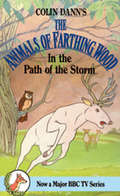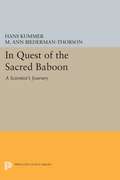- Table View
- List View
The Imperial Animal (Owl Bks.)
by Lionel Tiger Robin FoxThe Imperial Animal offers a compelling perspective on the controversy over humans and their biology. This now-classic study is about the social bonds that hold us together and the antisocial theories that drive us apart. The authors divulge how the evolutionary past of the species, reflected in genetic codes, determines our present and coerces our future. This book gives us a direct and intimate look at how we see ourselves. It offers insight into our politics, our ways of learning and teaching, reproducing and producing, playing and fighting.The authors assert that the purpose of this book is twofold: to describe what is known about the evolution of human behavior, and then to try to show how the consequences of this evolution affect our behavior today. To do this they draw from numerous disciplines—zoology, biology, history, and primatology, among others. In the new introduction, Tiger and Fox outline then- reasons for originally writing the book as well as the process they used to do their research. The Imperial Animal is a classic work that will continue to be of interest to sociologists, zoologists, biologists, and primatologists.
The Importance of Animal Experimentation for Safety and Biomedical Research
by S. Garattini D. W. Van BekkumScientists are coming under increasing pressure from activist groups to stop animal experimentation, branded as cruel and unnecessary for improving human health. This attitude, however, stems from an unrealistic evaluation of the situation and distorted information about present scientific knowledge. There is no question that most medical progress - perhaps all, in fac- has been attained through knowledge derived initially from experiments in various animal species. There is practically no way of replacing animals in these investigations and so-called 'alternative methods' are in reality merely complementary. Tissue cultures, cell, microorganisms, enzymes, membranes, mathematical models - all are useful for preliminary screening tests and for testing hypotheses, but the complexity of a living organism is such that in vivo studies are essential before any test can responsibly be made in man. This book presents the proceedings of an international symposium organized in Strasbourg (October 24-25, 1988), with the aim of assessing present-day requirements as regards animal experimentation in research related to major medical and toxicological problems still awaiting solutions.
The Importance of Aquatic-Terrestrial Ecotones for Freshwater Fish (Developments in Hydrobiology #105)
by F. Schiemer M. Zalewski J. E. ThorpeEcotones are interface zones between different ecosystems. Their ecological role and significance with regard to ecological management and conservation has become increasingly appreciated. For the management of freshwater resources, for example, an improved understanding of the role of land/inland water interfaces, will be essential for reducing negative human impacts by engineering, nutrient loading, siltation, etc. The management of ecotones, on the other hand, offers the possibility to control aquatic system processes via stock control of fish populations. Fish apparently are both excellent indicators of ecotone quality as well as determiners of its structure and function.
Impossible Monsters: Dinosaurs, Darwin and the War Between Science and Religion
by Michael TaylorImpossible Monsters is the captivating story of the discovery of the dinosaurs and how it upended our understanding of the origins of the world.‘An astonishing book about an extraordinary subject' PETER FRANKOPAN'As thrilling as it is sweeping' TOM HOLLAND‘The most talented young historian around ... A triumph’ SATHNAM SANGHERAIn 1811, a twelve-year-old girl uncovered some strange-looking bones in Britain’s southern shoreline. They belonged to no known creature and were buried beneath a hundred feet of rock. Over the next two decades, as several more of these ‘impossible monsters’ emerged from the soil, the leading scientists of the day were forced to confront a profoundly disturbing possibility: the Bible, as a historical account of the Earth's origins, was wildly wrong.This is the dramatic story of the crisis that engulfed science and religion when we discovered the dinosaurs. It takes us into the lives and minds of the extraordinary men and women who made these heretical discoveries, those who resisted them, as well as the pioneering thinkers, Darwin most famous among them, who took great risks to construct a new account of the earth’s and mankind’s origins.Impossible Monsters is the riveting story of a group of people who not only thought impossible things but showed them to be true. In the process they overturned the literal reading of the Bible, liberated science from the authority of religion and ushered in the secular age.‘Truly marvellous ... an intellectual thriller’ RICHARD HOLMES‘A stunning work ... of surprises and revelations’ STEVE BRUSATTE
Improvement of Cereal Quality by Genetic Engineering
by R. Henry J. A. RonaldsIf I had to nominate an area of food production in which science has played a major role in addressing product quality to meet market needs I would not pass by the intimate rela tionship of cereaI chemistry with cereaI plant breeding programs. In Australia, cereaI chemistry and product quality labs ha ve long been associated with wheat and barley breeding programs. Grain quality characteristics have been principal factors determining registration of new cultivars. This has not been without pain in Australia. On the one hand some cultivars with promising yield and agronomic characteristics have been rejected on the basis of quality characteristics, and for a period our breeders imposed selection regimes based on yield which resulted in declining quality characteristics. In the end the market provides the critic al signals. For many years Australia held a commanding market position on the basis of a single quality image, initiaHy based on bulked wheat of fair/average quality (FAQ). Later this was improved by segregation into four broad classes* based around Australian Standard White (ASW). This is no longer a viable marketing strategy. We were probably a little slow in rec ognising the mosaic of present day wheat markets, but now have up to 18 different grades available. Around the world wheat is a grain with many end uses. Its use in bread is expanding.
Improving Animal Welfare: A Practical Approach
by Madonna Benjamin Courtney Lynd Daigle Derek Donkin Anne Marie Anne Marie Lily N. Edwards-Callaway Wendy K Fulwider Dr Camie Heleski Hubert J. Karreman David Main Dr Amy McLean David J Mellor Siobhan Mullan Bernard Rollin Jeffrey Rushen Jan Shearer Kevin Stafford Janice Swanson Kurt Vogel Helen Whay Tina Widowski Jennifer Woods Steven Yik Upinder Kaur Richard M. Voyles Shawn DonkinCompletely revised, updated and with four new chapters on sustainability, new technologies, precision agriculture and the future of animal welfare, the third edition of this highly successful textbook: · Is edited by an outstanding world expert on animal welfare. · Emphasizes throughout the importance of measuring conditions that compromise welfare, such as lameness, heat stress, body condition, and bruises during transport. · Combines scientific information with practical recommendations for use on commercial operations. · Reviews practical information on livestock handling, euthanasia, slaughter, pain relief, and assessments of abnormal behavior. Improving Animal Welfare: A Practical Approach remains essential reading for students and practitioners of ethology, animal and veterinary science, veterinary medicine, as well as those working directly with farm animals and committed to improving their welfare.
Improving Animal Welfare: A Practical Approach
by Anne De Passillé Lily Nowell Edwards Camie Heleski Jeff Hill David Main Amy McLean David J Mellor Bernard Rollin Jeffrey Rushen Jan Shearer Kevin Stafford Janice Swanson Helen Whay Tina Widowski Jennifer WoodsBy taking an entirely practical approach, this textbook aims to help those working with animals to apply methods for improving welfare, bridging the gap between scientific research and practical application. This book provides a guide to practical evaluation and auditing of welfare problems for farmed animals, emphasizing the importance of measuring conditions that compromise welfare such as lameness, or the use of electric goads. This second edition is fully updated with new literature, new, up to date coverage of pain management, and the addition of a new chapter on animal welfare in organic farming systems.
Improving Genetic Disease Resistance in Farm Animals: A Seminar in the Community Programme for the Coordination of Agricultural Research, held in Brussels, Belgium, 8–9 November 1988 (Current Topics in Veterinary Medicine #52)
by Akke Jitske Akkermans W. SybesmaThis publication contains the proceedings of a seminar held in Brussels on November 8-9, 1988. The title of the seminar was "Reducing the costs of disease by improving resistance through genetics". The seminar was held as an activity of the Community Programme for the Coordination of Agricultural Research, 1984-1988. Costs of disease depend on losses caused by morbidity, mortality and production decreases and on the costs of preventive measures including vaccination and medication. Production losses often contribute a major portion to the total costs. To reduce costs of disease preventive measures like vaccination, preventive medication and hygienic procedures are applied. Genetic resistance is an attractive preventive measure because of its consistent nature in the next generations, because it precludes veterinary services and because there are no side-effects. Constraints are the long term investment, relatively slow progress per generation (in combination with production traits) and the considerable lack of knowledge about inheritance of resistance mechanisms in farm animals.
Improving GIS-based Wildlife-Habitat Analysis (SpringerBriefs in Ecology)
by Jeffrey K. Keller Charles R. SmithGeographic Information Systems (GIS) provide a powerful tool for the investigation of species-habitat relationships and the development of wildlife management and conservation programs. However, the relative ease of data manipulation and analysis using GIS, associated landscape metrics packages, and sophisticated statistical tests may sometimes cause investigators to overlook important species-habitat functional relationships. Additionally, underlying assumptions of the study design or technology may have unrecognized consequences. This volume examines how initial researcher choices of image resolution, scale(s) of analysis, response and explanatory variables, and location and area of samples can influence analysis results, interpretation, predictive capability, and study-derived management prescriptions. Overall, most studies in this realm employ relatively low resolution imagery that allows neither identification nor accurate classification of habitat components. Additionally, the landscape metrics typically employed do not adequately quantify component spatial arrangement associated with species occupation. To address this latter issue, the authors introduce two novel landscape metrics that measure the functional size and location in the landscape of taxon-specific ‘solid’ and ‘edge’ habitat types. Keller and Smith conclude that investigators conducting GIS-based analyses of species-habitat relationships should more carefully 1) match the resolution of remotely sensed imagery to the scale of habitat functional relationships of the focal taxon, 2) identify attributes (explanatory variables) of habitat architecture, size, configuration, quality, and context that reflect the way the focal taxon uses the subset of the landscape it occupies, and 3) match the location and scale of habitat samples, whether GIS- or ground-based, to corresponding species’ detection locations and scales of habitat use.
IMPROVING THE RIDER'S POSITION (Threshold Picture Guides #32)
by JONI BENTLEYThis illustrated guide explains how to achieve a poised and effective riding position which will enhance performance and enable the rider to remain constantly in balance whether walking, trotting or cantering. It describes how to correct upper body alignment and improve leg positions, how to sit centrally on the seat bones and eliminate crooked posture, how to distribute your weight evenly, how to develop a sensitive rein contact, and how to avoid tension and fear while in the saddle.
In a Class of Their Own: A Detailed Examination Of Avian Forms And Functions (Fascinating Life Sciences Ser.)
by Gary Ritchison‘In Considerable Variety’: Introducing the Diversity of Australia’s Insects
by Tim R. NewThe book introduces basic entomology, emphasising perspectives on insect diversity important in conservation assessment and setting priorities for management, as a foundation for managers and others without entomological training or background. It bridges the gap between photographic essays on insect identification and more technical texts, to illustrate and discuss many aspects of taxonomic, ecological and evolutionary diversity in the Australian insect fauna, and its impacts in human life, through outlines of many aspects of insect natural history.
In Defence of Dogs: Why Dogs Need Our Understanding
by John BradshawA dog is not for Christmas. This is.John Bradshaw, one of the world's leading dog experts, brings us a compelling insight into what dogs would ask us for, if only they knew how.The dog has been mankind's faithful companion for tens of thousands of years, yet today finds itself in crisis throughout the western world. Until just over a hundred years ago, most dogs worked for their living, and each of the many breeds had become well suited, over countless generations, to the task for which they were bred. Now, in their purely domestic roles we fail to understand their needs. And it is time that someone stood up for dogdom: not the caricature of the wolf in a dog suit, ready to dominate its unsuspecting owner at the first sign of weakness, not the trophy animal that collects rosettes and kudos for its breeder, but the real dog, the pet that just wants to be one of the family and enjoy life. Biologists now know far more about what really makes dogs tick than they did twenty years ago, but this new understanding has been slow to percolate through to owners, and has not yet made enough of a difference to the lives of the dogs themselves. This book is here to set the record straight.
In Defense of the World’s Most Despised Species: Why we love some species but hate most, and why it matters
by Ernest SmallSome animals and plants injure or kill millions of people annually, others cause trillions of dollars in property damage and loss. Such harmful species are understandably hated. However, the vast majority of the planet’s millions of species are disliked simply because of how they look and act. This bias is endangering numerous species that play important roles in maintaining both the natural ecosystems and the human economies of the world. In Defense of the World’s Most Despised Species examines the psychological motivations that lead people to make judgments about the attractiveness of species, noting the overwhelming importance of visual cues. It describes in considerable detail the physical and behavioral traits of species that lead us to love or hate them. Full color illustrations throughout present beautiful, charming animals and plants, species that seem loathsome, behavior of people in relation to such divergent species and their characteristics, and numerous explanatory diagrams of relevant biological and psychological phenomena. The aim of this book is to give readers insights into how we humans arrive at biased judgments and to promote the welfare of valuable, albeit sometimes unlovable animals and plants that consequently suffer from discrimination. Many of the ugliest, most disgusting, and feared species, such as vultures, toads, hyenas, sharks, spiders, and even the vast majority of cockroaches, in reality are some of our most valuable friends. Features Theme of the book – human preferences for and against species – is novel, scarcely examined to date. Multidisciplinary analysis, especially psychology, biological conservation science, and ecology, as well as philosophy, agriculture, urban planning, human health, and law. Text is accessible, user-friendly, concise, and well-organized, making numerous complex topics comprehensible, readable not only by specialists, but also by students and the educated layperson. Includes over 2,000 high-quality, entertaining, and informative color figures.
In Defense of the World’s Most Despised Species: Why we love some species but hate most, and why it matters
by Ernest SmallSome animals and plants injure or kill millions of people annually, others cause trillions of dollars in property damage and loss. Such harmful species are understandably hated. However, the vast majority of the planet’s millions of species are disliked simply because of how they look and act. This bias is endangering numerous species that play important roles in maintaining both the natural ecosystems and the human economies of the world. In Defense of the World’s Most Despised Species examines the psychological motivations that lead people to make judgments about the attractiveness of species, noting the overwhelming importance of visual cues. It describes in considerable detail the physical and behavioral traits of species that lead us to love or hate them. Full color illustrations throughout present beautiful, charming animals and plants, species that seem loathsome, behavior of people in relation to such divergent species and their characteristics, and numerous explanatory diagrams of relevant biological and psychological phenomena. The aim of this book is to give readers insights into how we humans arrive at biased judgments and to promote the welfare of valuable, albeit sometimes unlovable animals and plants that consequently suffer from discrimination. Many of the ugliest, most disgusting, and feared species, such as vultures, toads, hyenas, sharks, spiders, and even the vast majority of cockroaches, in reality are some of our most valuable friends. Features Theme of the book – human preferences for and against species – is novel, scarcely examined to date. Multidisciplinary analysis, especially psychology, biological conservation science, and ecology, as well as philosophy, agriculture, urban planning, human health, and law. Text is accessible, user-friendly, concise, and well-organized, making numerous complex topics comprehensible, readable not only by specialists, but also by students and the educated layperson. Includes over 2,000 high-quality, entertaining, and informative color figures.
In The Grip Of Winter: "in The Grip Of Winter", "fox's Feud" And "fox Cub Bold" (The\farthing Wood Ser. #Vol. 2)
by Colin DannIn the depths of winter, with snow thick on the ground, Badger lies alone and injured. No one knows where he is, and the icy cold is tightening its grip every second.What will happen to Badger? And can the other animals of Farthing Wood survive the harsh cold and piercing hunger that winter has brought?
In Nature's Interests?: Interests, Animal Rights, and Environmental Ethics (Environmental Ethics and Science Policy Series)
by Gary E. VarnerThis book offers a powerful response to what Varner calls the "two dogmas of environmental ethics"--the assumptions that animal rights philosophies and anthropocentric views are each antithetical to sound environmental policy. Allowing that every living organism has interests which ought, other things being equal, to be protected, Varner contends that some interests take priority over others. He defends both a sentientist principle giving priority to the lives of organisms with conscious desires and an anthropocentric principle giving priority to certain very inclusive interests which only humans have. He then shows that these principles not only comport with but provide significant support for environmental goals.
In or Out: A Tale Of Cat Versus Dog
by Stacy GreggA hilarious story about friendship, patience and paw-prints! Brilliantly written by Stacy Gregg and illustrated by Sarah Jennings.
In The Path Of The Storm (The\farthing Wood Ser. #Vol. 6)
by Colin Dann'I mean to be not only the leadero f the deer herd but Lord of the Reserve. So you must stay in your corner of the Park, all of you... otherwise you'll be permitted here no longer.'Trey, the new leader of the deer herd of White Deer Park, has decided that there is no room for the smaller animals in the reserve.The future looks very bleak for Badger, Adder, Owl and the others - and then the night of the great storm brings more danger . . .
In Praise of Bees: A Cabinet of Curiosities
by Elizabeth BirchallThis fascinating and comprehensive book explores the bee's place in human society from prehistoric cave paintings and inscribed clay tablets through to our contemporary world - a cabinet whose drawers are filled with nuggets of bee science and practical beekeeping, myth, religion, politi, philosophy and folklore. There is a selection of verse and a rich variety of illustrations ranging from Old Masters and scientific etchings to modern photographs. An in-depth look at bees' complex society and their present plight, the ongoing political and scientific to and fro regarding pesticides and other threats are also discussed, given the bee's importance as plant pollinator in agriculture and the wild.
In Praise of Famous Horses: An A-Z of the Most Celebrated in History and Culture, Myth and Sport
by Sean MageeHorses is an A-Z companion to perhaps the most loved of all domesticated animals. The book's entries include a wealth of unexpected, fascinating and serendipitous information, from horse-slang phrases to horses in British pub signs, and from the horse in advertising to the horse as a food item. Themes such as the horse in warfare and the horse in folklore abound.These features add up to a richly satisfying accumulation of information about the horse's role in human culture and society over two millennia. Horses will not only be a helpful reference source and congenial bedside book for those who work with or enjoy horses, but also a satisfying and browsable companion for the inquisitive general reader.
In Pursuit of Butterflies: A Fifty-year Affair
by Matthew OatesMatthew Oates has led a butterflying life. Naturalist, conservationist and passionate lover of poetry, he has devoted himself to these exalted creatures: to their observation, to singing their praises, and to ensuring their survival. Based on fifty years of detailed diaries, In Pursuit of Butterflies is the chronicle of this life. Oates leads the reader through a lifetime of butterflying, across the mountain tops, the peat bogs, sea cliffs, meadows, heaths, the chalk downs and great forests of the British Isles. Full of humour, zeal, digression, expertise and anecdote, this book provides a profound encounter with one of our great butterfly lovers, and with a half-century of butterflies in Britain.
In Quest of the Sacred Baboon: A Scientist's Journey
by Hans Kummer M. Ann Biederman-ThorsonIn a tale that begins at a zoo in Zurich and takes us across the deserts of Ethiopia to the Asir Mountains in Saudi Arabia, Hans Kummer recreates the adventure and intellectual thrill of the early days of field research on primates. Just as Jane Goodall and Dian Fossey introduced readers to the fascinating lives of chimpanzees and gorillas, Kummer brings us face to face with the Hamadryas baboon. With their furry white mantles and gleaming red hindquarters, the Hamadryas appear frequently in the art of the ancient Egyptians--who may have interpreted the baboons' early morning grooming rituals as sun-worshiping rites. Back then, Hamadryas were thought to be incarnates of Thoth, the god of wisdom; today they are considered to have one of the most highly structured social systems among primates, very close, in some respects, to that of humans. In the 1960s, Kummer, after conflicts with nomadic warriors, managed to track down these elusive baboons near the Danakil Desert, and then followed them from dawn to dusk on their treks from one feeding place to another. His scientific account of this period reads like a travel memoir as he describes his encounters with the Hamadryas and the people with whom they share the desert. Winding his way through cliffs and stubble, Kummer records the baboons' social life, from the development of pair relationships to the way an entire group decides where to march each day. Much like the human nomads who cope with the harsh demands of the desert environment, the Hamadryas maintain a society that is strict and patriarchal in its details but multilayered and flexible in its largest units. We learn, for example, of the Hamadryas' respect for possession that protects family structure and of the cohesion among family leaders that lessens the threat of battle. At the same time, clear-cut personalities emerge from Kummer's account, drawing us into the life stories and power struggles of individual baboons. Whereas this rich detail holds many implications for natural scientists, the colorful way it comes to life makes for a compelling book bound to entertain and educate all readers.Originally published in 1997.The Princeton Legacy Library uses the latest print-on-demand technology to again make available previously out-of-print books from the distinguished backlist of Princeton University Press. These editions preserve the original texts of these important books while presenting them in durable paperback and hardcover editions. The goal of the Princeton Legacy Library is to vastly increase access to the rich scholarly heritage found in the thousands of books published by Princeton University Press since its founding in 1905.
In Search of Lost Frogs
by Dr Robin MooreOn August 9, 2010, 33 teams from 21 countries were dispatched to search for the Lost Frogs identified by Conservation International. On their list were a host of species including, in the top ten most wanted, the Rio Pescado Stubfoot Toad, found only in Ecuador - which was to prove a triumphant rediscovery. Several months, a number of key rediscoveries - such as the Elegant Tropical Frog, last seen in 1937 and the Chalazodes Bubble-nest Frog - last seen in 1874 and two new species later, the Search for Lost Frogs had generated more than 650 news articles in 20 countries and over a billion potential viewers. Author Robin Moore was responsible for spearheading the Search for Lost Frogs and coordinating the teams. He also co-led two expeditions to Colombia and Haiti. In Colombia in search of the Mesopotamia Beaked Toad, the steamy jungles of the Choco yielded not the desired species but a brand new one - the Mr. Burns Toad, so-called because of an uncanny resemblance to the Simpsons' character; the species was selected as one of Time magazine's top ten new species of 2010. In Haiti the team found six frogs last seen 20 years before, including the Ventriloqual Frog, named for its ability to throw its voice. This fascinating new book tells the story of the expedition - its highs and lows, discoveries and failures and the campaign's ongoing work. Despite the campaign, one third of the world's amphibians remain threatened with extinction. Most of the species searched for were not found. But those that were provide a glimmer of hope. Understanding why these species have survived when many others have not should help us understand what makes these species different. In Search of Lost Frogs is a story of perseverance, disappointment, rediscovery, resilience, but ultimately of hope, written with passion and illustrated with the author's superb photographs.
